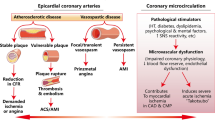Abstract
Re-establishing coronary blood flow to a segment of myocardium suffering from cessation or diminution of flow, either with surgical or percutaneous approaches, may be complicated by injury to the myocardium. During surgical revascularization with coronary artery bypass grafting (CABG), aortic cross-clamping and subsequent reduction in oxygen transport to the myocardium may result in cardiac myocyte injury and myonecrosis. This injury can be compounded if protection of the myocardium using myocardial protective strategies is not adequate. Ischemia/reperfusion cellular alterations may contribute to this injury as well. Percutaneous coronary interventions (PCI) are also associated with myonecrosis resulting from side branch compromise, distal embolization of debris, and plugging of the microcirculation, as well as ischemia/reperfusion injury. Intracoronary filtering devices have not been shown to improve outcomes associated with such complications. Which revascularization strategy is associated with superior outcomes and less cardiac myocyte necrosis is an area of continuing controversy.




Similar content being viewed by others
References
Khabbaz KR, Zankoul F, Warner KG (2001) Intraoperative metabolic monitoring of the heart: II. Online measurement of myocardial tissue pH. Ann Thorac Surg 72(6):S2227–S2234
Kloner RA, Przklenk K, Kay GL (1994) Clinical evidence for stunned myocardium after coronary artery bypass surgery. J Cardiac Surg 9(Suppl):397–402
Stamm C, Friehs I, Cowan DB, et al. (2002) Dopamine treatment of postischemic contractile dysfunction rapidly induces calcium-dependent pro-apoptoptic signaling. Circulation 106:I-290
Khuri SF, Healey NA, Hossain M, et al. (2005) Intraoperative regional myocardial acidosis and reduction in long-term survival after cardiac surgery. J Thorac Cardiovasc Surg 129:372–381
Melrose DG, Dreyer B, Bentall HH, et al. (1955) Elective cardiac arrest. Lancet 2:21–22
Engelman R, Levitsky S (eds) (1982) A Textbook of Clinical Cardioplegia. New York: Futura Publishing Co
Buckberg GD (1979) A proposed “solution” to the cardioplegic controversy. J Thorac Cardiovasc Surg 77:803–815
Menasché P (1993) Simplified method for delivering normothermic blood cardioplegia. Ann Thorac Surg 55:177–178
Kini AS, Lee P, Marmur JD, et al. (2004) Correlation of postpercutaneous coronary intervention creatinine kinase-MB and troponin 1 elevation in predicting mid-term mortality. Am J Cardiol 93:18–23
Stone GW, Mehran R, Dangas G, et al. (2001) Differential impact on survival of electrocardiographic Q-wave versus enzymatic myocardial infarction after percutaneous intervention: a device-specific analysis of 7147 patients. Circulation 104:642–647
Abdelmeguid AE, Topol EJ (1996) The myth of the myocardial “infarctlet” during percutaneous coronary revascularization. Circulation 94:3369–3375
Akkerhuis KM, Alexander JH, Tardiff BE, et al. (2002) Minor myocardial damage and prognosis: are spontaneous and percutaneous coronary intervention-related events different? Circulation 105:554
Stone GW, Mehran R, Dangas G, et al. (2001) Differential impact on survival of electrocardiographic Q-wave versus enzymatic myocardial infarction after percutaneous intervention: a device-specific analysis of 7147 patients. Circulation 104:642–647
Pompa JJ, Cox N, Hauptmann KE, et al. (2002) Initial clinical experience with distal protection using the filter-wire in patients undergoing coronary artery and saphenous vein graft percutaneous intervention. Catheter Cardiovasc Interv 57:125–134
Dudek D, Mielecki W, Dziewierz A, et al. (2005) The role of thrombectomy and embolic protection devices. Eur Heart J 7(Suppl):15–20
Hannon El, Racz MJ, Walford G, et al. (2005) Long-term outcomes of coronary-artery bypass grafting versus stent implantation. N Engl J Med 352:2174–2183
Gersch BJ, Frye RL (2005) Methods of coronary revascularization – things may not be as they seem. N Engl J Med 352:2235–2237
Costa MA, Carere RG, Lichtenstein SV, et al. (2001) Incidence, predictors and significance of abnormal cardiac enzyme rise in patients treated with bypass surgery in the arterial revascularization therapies study (ARTS). Circulation 104:2689–2693
Brenner SJ, Lytle BW, Schneider JP, et al. (2002) Association between CK-MB elevation after percutaneous or surgical revascularization and three-year mortality. J Am Coll Cardiol 40:1961–1967
Selvanayagam JB, Pigott D, Balacumaraswami L, et al. (2005) Relationship of irreversible myocardial injury to troponin I and creatinine kinase-MB elevation after coronary artery bypass surgery: Insights from cardiovascular magnetic resonance imaging. J Am Coll Cardiol 45:629–631
Taggart DP (2006) Heart of the matter. J Cardiothorac Surg 1:3
Author information
Authors and Affiliations
Corresponding author
Additional information
Presented in part as the 17th William W. L. Glenn Lecture at the American Heart Association, Scientific Sessions, 2005, and published in part in Levitsky S (2006) Protecting the myocardial cell during coronary revascularization. Circulation 114:I-339–I-343
Rights and permissions
About this article
Cite this article
Khabbaz, K.R., Levitsky, S. The Impact of Surgical and Percutaneous Coronary Revascularization on the Cardiac Myocyte. World J Surg 32, 361–365 (2008). https://doi.org/10.1007/s00268-007-9366-y
Published:
Issue Date:
DOI: https://doi.org/10.1007/s00268-007-9366-y




